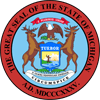
 Michigan
Michigan
Michigan has a strong, constitutional tax and expenditure limit. Approved by citizen initiative in 1978, Article IX Subsection 26 of the Michigan State Constitution, known as the Headlee Amendment, indexed revenue growth to state personal income growth. Similar to the Hancock Amendment in Missouri, if Michigan tax revenue exceeds the revenue limit by more than 1%, lawmakers must refund the excess revenue to Michigan income taxpayers. Another hallmark of stringent TELs, the Headlee Amendment requires the revenue and spending limits be adjusted when devolving authority to local governments.
Interestingly, most of the Headlee Amendment’s provisions relate to local taxation. Like the state government, Michigan local governments are required to seek voter approval before creating new taxes or increasing current tax rates. Initially, a locality’s total taxable property was not allowed to increase by more than the rate of inflation. If total taxable property increased faster than the rate of inflation, the Headlee Amendment required property tax rates be adjusted back to inflation, also known as a “Headlee Rollback.”
Approved by voters in 1994, Proposal A overhauled a handful of the Headlee Amendment’s provisions. In addition to increasing the maximum allowable state sales tax rate, Proposal A also required the taxable value of individual parcels of property not grow faster than inflation. This is a significant shift from the original policy because individual taxable property could increase faster than inflation as long as the locality’s total taxable property did not. Finally, Proposal A also abolished so-called “Headlee Roll-ups.” If the value of total taxable property increased slower than inflation, localities were allowed to increase property tax rates so property tax revenues kept pace with inflation. Under Proposal A, localities were no longer allowed to increase property tax rates to match inflation, only “Headlee Rollbacks” were allowed. Proposal A reformed the Headlee Amendment into a stronger protection for individual property owners.
| Year | Inflation-adjusted Actual Spending |
|---|---|
| 1992 | 26,450,550,000 |
| 1993 | 26,787,350,000 |
| 1994 | 28,336,000,000 |
| 1995 | 36,108,000,000 |
| 1996 | 38,473,050,000 |
| 1997 | 35,611,590,000 |
| 1998 | 40,083,110,000 |
| 1999 | 40,898,450,000 |
| 2000 | 40,519,650,000 |
| 2001 | 42,355,480,000 |
| 2002 | 43,585,920,000 |
| 2003 | 41,893,070,000 |
| 2004 | 39,576,970,000 |
| 2005 | 38,883,880,000 |
| 2006 | 38,695,300,000 |
| 2007 | 38,417,130,000 |
| 2008 | 37,586,280,000 |
| 2009 | 34,789,200,000 |
| 2010 | 33,577,400,000 |
| 2011 | 32,980,160,000 |
| 2012 | 33,602,920,000 |
| 2013 | 33,270,250,000 |
| 2014 | 34,339,250,000 |
| 2015 | 35,387,940,000 |
| 2016 | 35,998,560,000 |
| 2017 | 36,136,460,000 |
| 2018 | 36,956,400,000 |
| 2019 | 38,216,380,000 |
| 2020 | 33,916,000,000 |